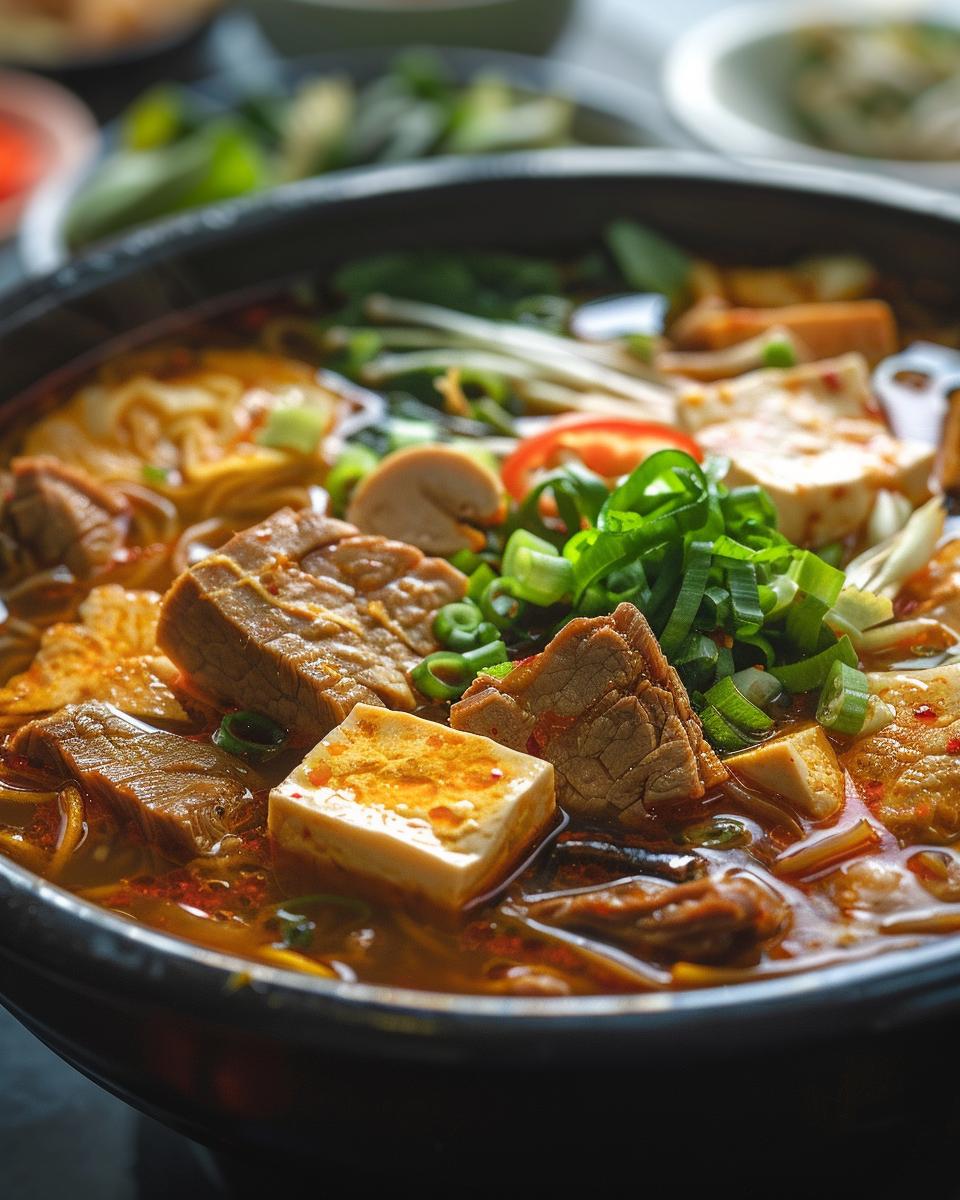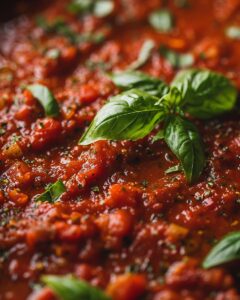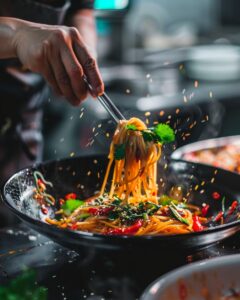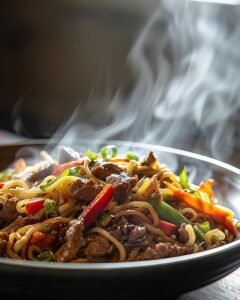Mala Tang Recipe Unveiled: Sizzle Up Your Taste Buds
Ever craved something spicy, numbing, yet utterly delicious? The mala tang recipe might just be your next favorite dish. This Sichuan delight combines bold flavors and various textures to create a feast for your senses. Perfect for those who love a culinary challenge or simply want to sizzle up their taste buds!
In this recipe:
- The secret to the perfect mala tang broth
- Choosing the right ingredients for your taste
- Step-by-step cooking instructions
- Tips for customizing your mala tang experience
Furthermore, if you’re on the hunt for more unique recipes, why not unleash umami magic with our Trader Joe’s noodles recipe? Or, for an extra kick, you can elevate your meals with our Korean soy garlic sauce recipe. Both are guaranteed to complement your mala tang adventure and impress anyone at your dining table.
So, are you ready to dive into the world of mala tang? Let’s embark on this flavorful journey together, and trust me, your taste buds will thank you!
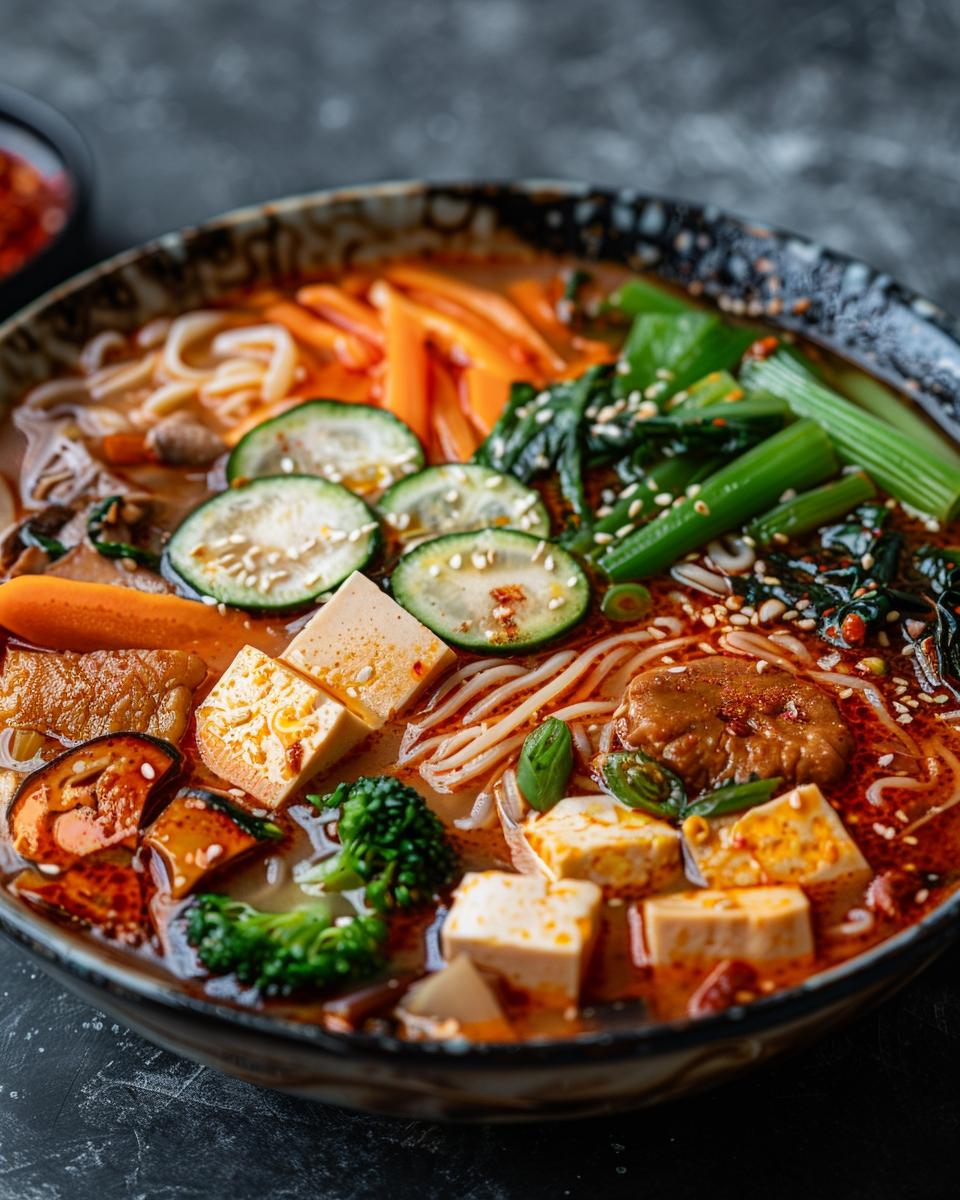
Who Can Whip Up This Malatang?
So, you’re intrigued by the tantalizing flavors of malatang, but wonder if you can make it yourself? The good news is, with the right simple malatang recipe, anyone from beginners to seasoned chefs can master this dish. This guide will help you understand the skill level required, the essential tools, and how to adapt the recipe for vegetarian preferences.
Firstly, making an authentic malatang recipe doesn’t require professional culinary skills. It does, however, demand a bit of patience and love for spicy, numbing flavors. If you’re a fan of experimenting in the kitchen, malatang is a delightful challenge.
Essential Tools and Equipment
Before diving into the cooking process, ensure you have the necessary tools:
- A large pot for the broth
- A strainer or slotted spoon for ingredients
- Chopsticks or tongs for serving
These tools are key for a smooth malatang preparation. Now, let’s talk adaptation. For those seeking a malatang recipe vegetarian twist, it’s quite simple. You can easily swap out meat-based ingredients with tofu, mushrooms, and various veggies. The beauty of malatang lies in its versatility.
Finally, remember, the heart of malatang is its broth. Achieving the perfect balance of spicy and numbing is crucial. For those ready to embark on this culinary adventure, check out this detailed guide on The Mala Market for more insights and tips on perfecting your malatang.
Whether you’re a novice in the kitchen or a cooking enthusiast, malatang is a rewarding dish to try. With a bit of practice and the right ingredients, you’ll be whipping up this Sichuan delicacy in no time!
Gathering Your Malatang Ingredients
Now that we’ve covered the minimal equipment needed, let’s dive into the heart of any delicious malatang—the ingredients. Choosing the right ingredients is crucial. It’s what elevates your malatang from good to unforgettable. Ever wondered why some recipes just taste better? It often boils down to the quality and authenticity of the ingredients used.
Let’s Talk Ingredients
For the best malatang recipe, you’ll need a mix of fresh and pantry items. Fresh items bring vibrancy and crunch, while pantry staples add depth and soul. Here’s a comprehensive list to get you started:
- Fresh vegetables like spinach, bok choy, and mushrooms
- Proteins such as thinly sliced beef, tofu, and fish balls
- Noodles of your choice, rice noodles work great
- For the broth: chicken or vegetable stock
- Spices for the mala sauce ingredients: Sichuan peppercorns, dried chili peppers, star anise, and garlic
But, where to find authentic Chinese ingredients? Local Asian markets are treasure troves. Also, many online stores now offer high-quality, authentic ingredients. Don’t shy away from asking staff for recommendations. They can guide you to the best products for your malatang ingredients.
Remember, the essence of malatang lies in its mala sauce ingredients. The unique combination of Sichuan peppercorns and dried chili peppers gives it that distinctive numbing and spicy flavor. Experiment with the amounts to tailor the spice level to your preference. Happy cooking!
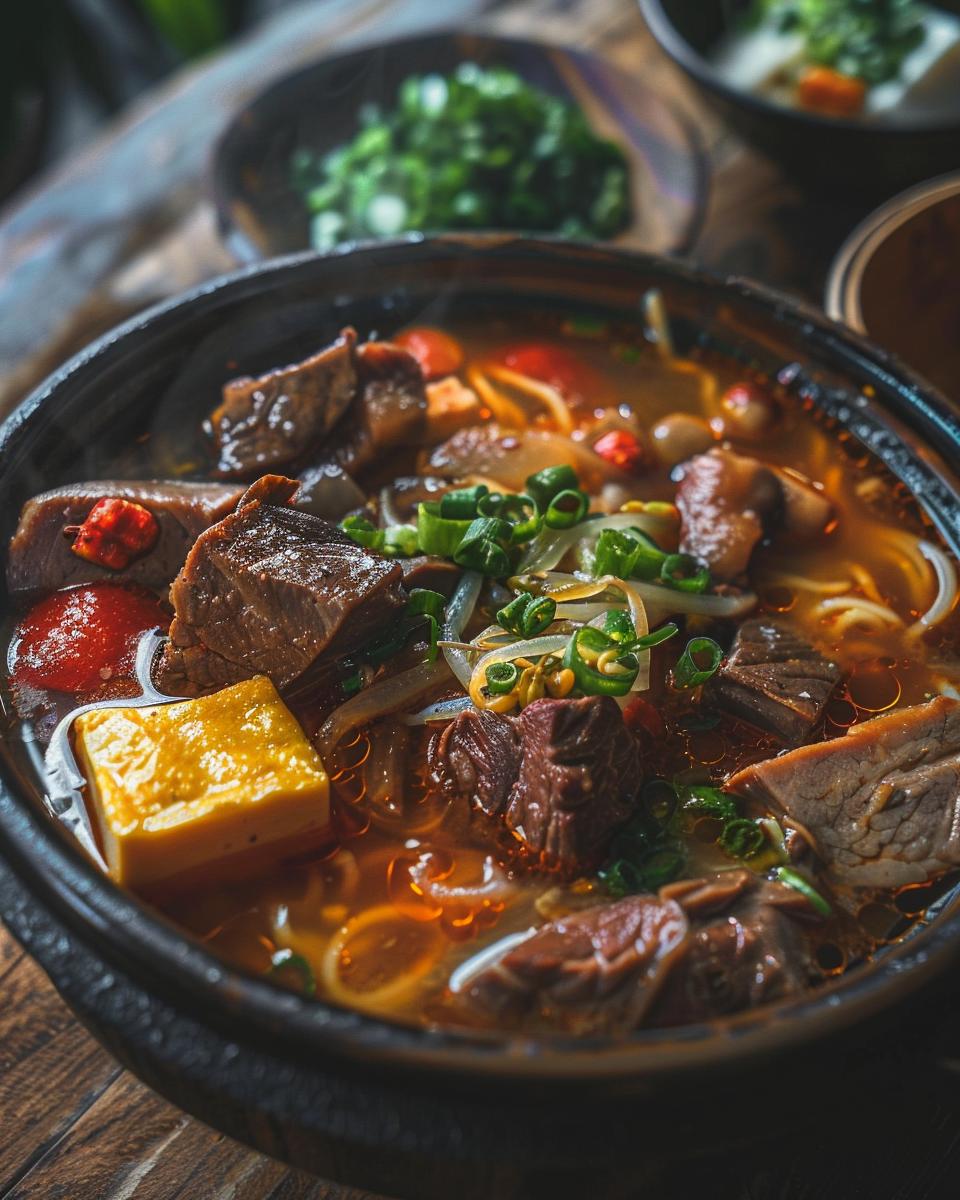
Step-by-Step Guide: Crafting Your Malatang
Now that we’ve gathered all the necessary ingredients, let’s dive into the heart of making a mouth-watering malatang. Preparing this dish is an art, but don’t worry, I’ll guide you through each step. Ready to unleash the flavors?
First off, the malatang soup base is where it all begins. Think of it as the canvas for our masterpiece. You’ll want to start by bringing a pot of water to a boil. Then, add your chosen malatang soup base. Whether you’re going for a spicy malatang recipe or a milder version, this base will set the tone.
Assembling Your Malatang
With the broth simmering and wafting its tantalizing aromas, it’s time to assemble the ingredients. Here’s where balance comes into play. Combine leafy greens, mushrooms, thin slices of meat, and noodles into the pot. Remember, variety is the spice of life, and in this case, it makes for a balanced dish.
Now, let’s talk spice. Adjusting the spice levels to taste is crucial. Not everyone can handle the heat of a traditional mala tang soup base. Feel free to tweak the amount of chili oil or peppercorns. After all, the goal is to enjoy every bite, not to challenge your spice tolerance (unless that’s your thing).
Give your concoction a good stir, letting all the ingredients cook evenly. Once everything is tender and infused with flavor, it’s time to serve. Ladle your malatang into bowls, making sure to get a good mix of broth, veggies, and proteins.
There you have it, your very own homemade malatang. Who knew crafting this delectable dish could be so simple yet so rewarding? Now, go ahead, indulge in the fruits of your labor, and savor every spicy, savory bite.
Serving and Storing Ideas
Now that you’ve mastered making malatang, let’s dive into the best part – serving and storing it. Indeed, the journey from a simmering pot of broth to a delightful bowl of malatang is thrilling. But, how do you ensure each serving is as flavorful as the last? And, what’s the secret to keeping it fresh? Let’s explore.
First off, the best malatang soup base is your foundation of flavor. It’s what makes or breaks your dish. So, have you chosen yours wisely? Remember, a great base is not just about the heat; it’s about depth and aroma, too. Then, there’s the joy of assembling your ingredients. Think of it as painting on a canvas, but with flavors. You’ll want a balance – proteins, veggies, and malatang noodles – to make each bite interesting.
Customizing Your Bowl
Here’s where it gets personal. Adjusting the spice levels to taste is crucial. Not everyone can handle the heat, right? Plus, with an easy malatang sauce recipe, tweaking the spice becomes a breeze. Mix it in gradually, tasting as you go, until it hits just the right note of fiery bliss.
But what about leftovers? Storing malatang is simple, yet essential. Cool it down quickly and refrigerate within two hours of cooking to keep it fresh. In a sealed container, your malatang can be a quick, delicious meal for the next few days. Just reheat gently, and it’s as good as new.
So, are you ready to serve up your masterpiece? And remember, the beauty of malatang is in its versatility. Each bowl is a new adventure. Enjoy the journey!

Pro Tip for Crafting the Perfect Malatang
- Firstly, always start with a high-quality mala tang recipe.
- Next, for a deeper flavor, toast the spices before grinding.
- Moreover, adjust the spice level by adding more or less chili oil.
- Additionally, use fresh ingredients for the best taste and texture.
- Also, remember to blanch meat and veggies before adding to the broth.
- Finally, serve with noodles or rice to soak up the delicious broth.
Malatang FAQ: Substitutions, Savings, and Suggestions
After diving into our pro tips, you’re likely brimming with curiosity about crafting the perfect malatang. Let’s tackle some of your burning questions with insights that’ll elevate your mala game!
Substitutions That Save the Day
Q: What can I use if I can’t find traditional malatang ingredients?
A: No worries! For hard-to-find items like specific mushrooms or noodles, consider alternatives that maintain the dish’s integrity. For instance, if wood ear mushrooms are elusive, try shiitake or even button mushrooms for that umami kick. Can’t find knife-cut noodles? Linguine makes a surprisingly good stand-in. It’s all about capturing the essence!
Q: Where to buy malatang sauce when it’s not available locally?
A: Online marketplaces like Amazon offer a wide range of mala sauce options. Also, exploring Asian markets or specialty stores online can uncover some gems. Don’t shy away from making your own sauce with a simple mala recipe!
Budget-Friendly Tips and Tricks
Q: How can I make malatang on a budget?
A: Focus on seasonal and local vegetables; they’re not only fresher but often cheaper. Bulk-buy staples like sichuan peppercorns and star anise online to save in the long run. Remember, recipes using mala sauce are versatile—feel free to adjust the ingredients based on what’s on sale or already in your pantry!
Q: Any suggestions for enhancing my malatang?
A: Absolutely! Experiment with different protein options like tofu for a budget-friendly twist. Incorporating a variety of textures, such as glass noodles for slurpability and crunchy vegetables, adds an exciting contrast. And don’t forget, a little goes a long way with potent spices, so adjust to taste!

